Entrepreneurial Ventures & Mindset Report: HNC Business Unit 9
VerifiedAdded on 2021/11/16
|44
|14566
|76
Report
AI Summary
This report, prepared for a Higher National Certificate/Diploma in Business, Unit 9: Entrepreneurship and Small Business Management, analyzes various aspects of entrepreneurship. It begins by examining different types of entrepreneurial ventures, including public entrepreneurship exemplified by ALIMCO, and their relation to entrepreneurial typologies, followed by a comparative analysis of entrepreneurial ventures. The report then assesses the impact of micro and small businesses on the economy using relevant data and statistics, and explains the importance of small businesses and start-ups to the growth of the social economy. Key characteristics, traits, and skills of successful entrepreneurs are determined, assessing how aspects of the entrepreneurial personality reflect motivation and mindset. The report also examines how background and experience can either hinder or foster entrepreneurship, supported by examples like Shree Mahila Griha Udyog Lijjat Papad, concluding with a comprehensive overview of the subject matter.
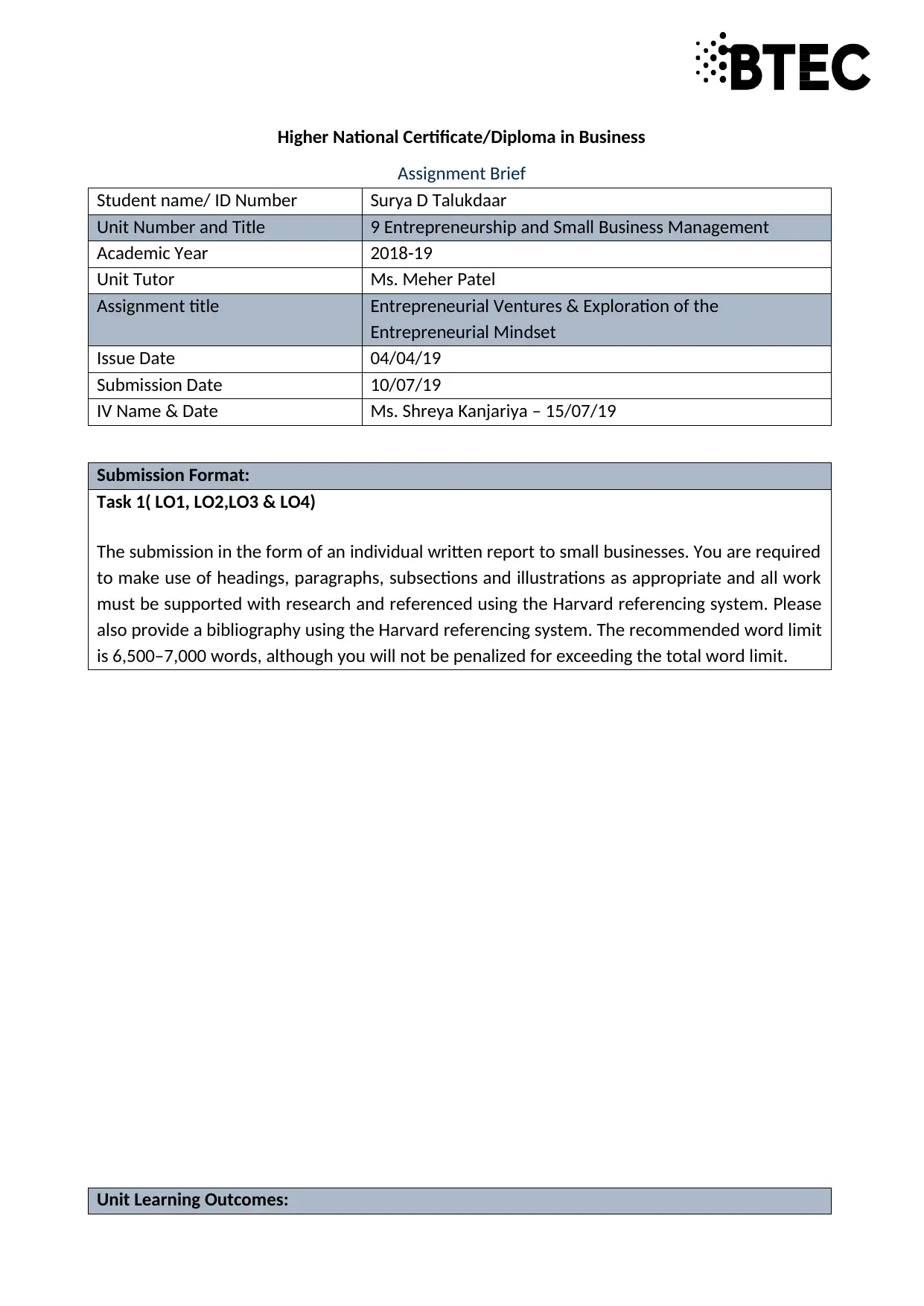
Higher National Certificate/Diploma in Business
Assignment Brief
Student name/ ID Number Surya D Talukdaar
Unit Number and Title 9 Entrepreneurship and Small Business Management
Academic Year 2018-19
Unit Tutor Ms. Meher Patel
Assignment title Entrepreneurial Ventures & Exploration of the
Entrepreneurial Mindset
Issue Date 04/04/19
Submission Date 10/07/19
IV Name & Date Ms. Shreya Kanjariya – 15/07/19
Submission Format:
Task 1( LO1, LO2,LO3 & LO4)
The submission in the form of an individual written report to small businesses. You are required
to make use of headings, paragraphs, subsections and illustrations as appropriate and all work
must be supported with research and referenced using the Harvard referencing system. Please
also provide a bibliography using the Harvard referencing system. The recommended word limit
is 6,500–7,000 words, although you will not be penalized for exceeding the total word limit.
Unit Learning Outcomes:
Assignment Brief
Student name/ ID Number Surya D Talukdaar
Unit Number and Title 9 Entrepreneurship and Small Business Management
Academic Year 2018-19
Unit Tutor Ms. Meher Patel
Assignment title Entrepreneurial Ventures & Exploration of the
Entrepreneurial Mindset
Issue Date 04/04/19
Submission Date 10/07/19
IV Name & Date Ms. Shreya Kanjariya – 15/07/19
Submission Format:
Task 1( LO1, LO2,LO3 & LO4)
The submission in the form of an individual written report to small businesses. You are required
to make use of headings, paragraphs, subsections and illustrations as appropriate and all work
must be supported with research and referenced using the Harvard referencing system. Please
also provide a bibliography using the Harvard referencing system. The recommended word limit
is 6,500–7,000 words, although you will not be penalized for exceeding the total word limit.
Unit Learning Outcomes:
Paraphrase This Document
Need a fresh take? Get an instant paraphrase of this document with our AI Paraphraser
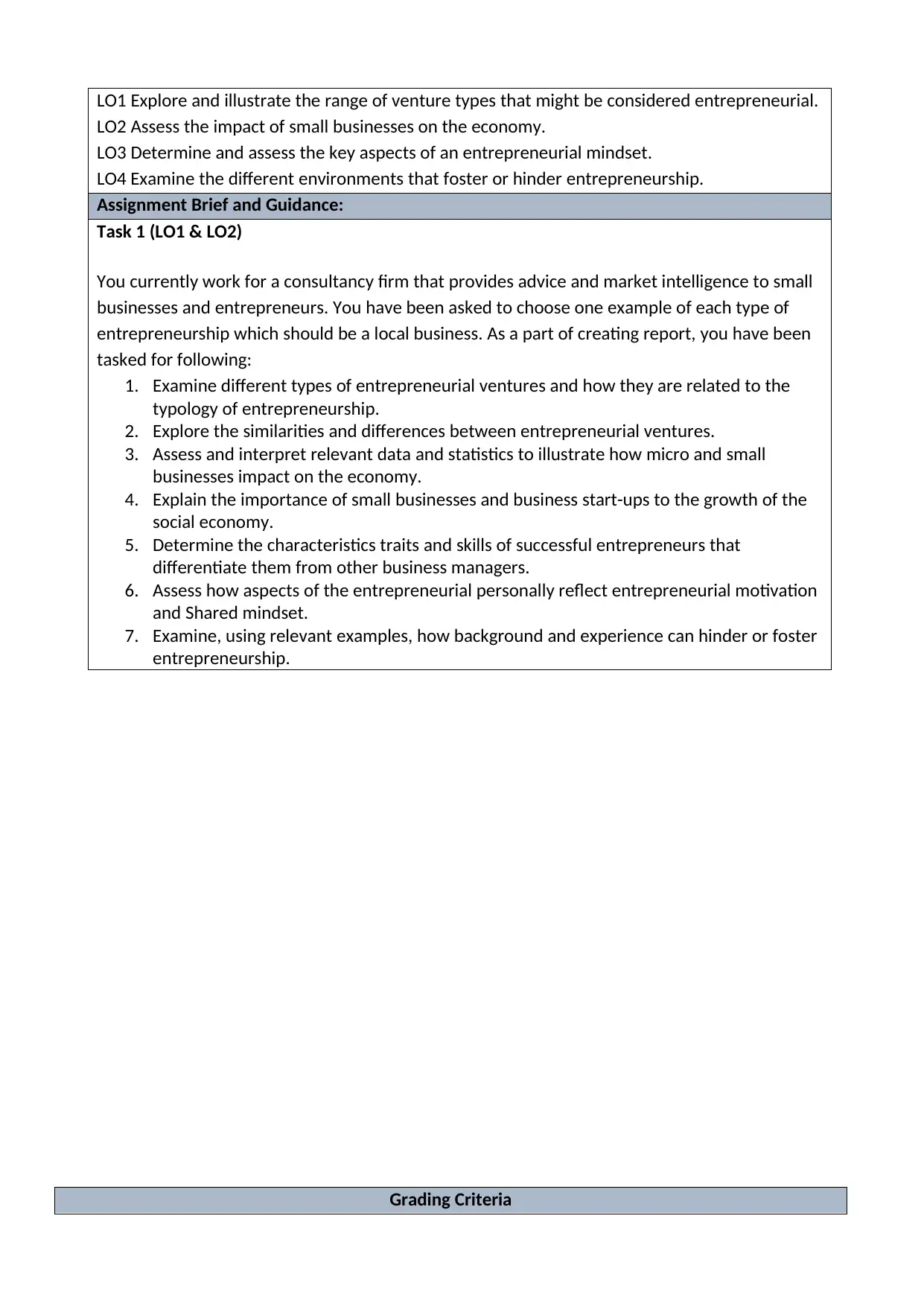
LO1 Explore and illustrate the range of venture types that might be considered entrepreneurial.
LO2 Assess the impact of small businesses on the economy.
LO3 Determine and assess the key aspects of an entrepreneurial mindset.
LO4 Examine the different environments that foster or hinder entrepreneurship.
Assignment Brief and Guidance:
Task 1 (LO1 & LO2)
You currently work for a consultancy firm that provides advice and market intelligence to small
businesses and entrepreneurs. You have been asked to choose one example of each type of
entrepreneurship which should be a local business. As a part of creating report, you have been
tasked for following:
1. Examine different types of entrepreneurial ventures and how they are related to the
typology of entrepreneurship.
2. Explore the similarities and differences between entrepreneurial ventures.
3. Assess and interpret relevant data and statistics to illustrate how micro and small
businesses impact on the economy.
4. Explain the importance of small businesses and business start-ups to the growth of the
social economy.
5. Determine the characteristics traits and skills of successful entrepreneurs that
differentiate them from other business managers.
6. Assess how aspects of the entrepreneurial personally reflect entrepreneurial motivation
and Shared mindset.
7. Examine, using relevant examples, how background and experience can hinder or foster
entrepreneurship.
Grading Criteria
LO2 Assess the impact of small businesses on the economy.
LO3 Determine and assess the key aspects of an entrepreneurial mindset.
LO4 Examine the different environments that foster or hinder entrepreneurship.
Assignment Brief and Guidance:
Task 1 (LO1 & LO2)
You currently work for a consultancy firm that provides advice and market intelligence to small
businesses and entrepreneurs. You have been asked to choose one example of each type of
entrepreneurship which should be a local business. As a part of creating report, you have been
tasked for following:
1. Examine different types of entrepreneurial ventures and how they are related to the
typology of entrepreneurship.
2. Explore the similarities and differences between entrepreneurial ventures.
3. Assess and interpret relevant data and statistics to illustrate how micro and small
businesses impact on the economy.
4. Explain the importance of small businesses and business start-ups to the growth of the
social economy.
5. Determine the characteristics traits and skills of successful entrepreneurs that
differentiate them from other business managers.
6. Assess how aspects of the entrepreneurial personally reflect entrepreneurial motivation
and Shared mindset.
7. Examine, using relevant examples, how background and experience can hinder or foster
entrepreneurship.
Grading Criteria
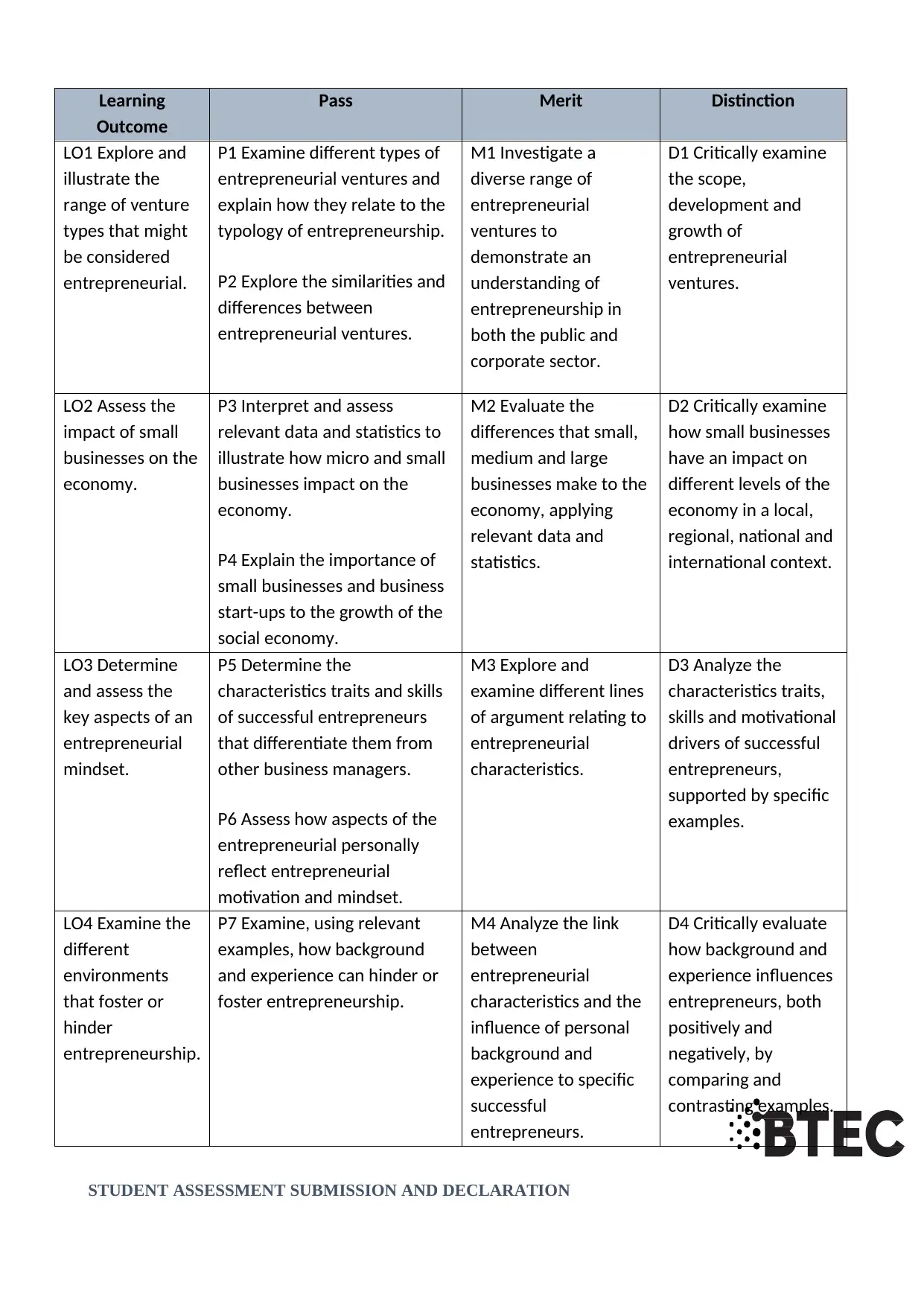
Learning
Outcome
Pass Merit Distinction
LO1 Explore and
illustrate the
range of venture
types that might
be considered
entrepreneurial.
P1 Examine different types of
entrepreneurial ventures and
explain how they relate to the
typology of entrepreneurship.
P2 Explore the similarities and
differences between
entrepreneurial ventures.
M1 Investigate a
diverse range of
entrepreneurial
ventures to
demonstrate an
understanding of
entrepreneurship in
both the public and
corporate sector.
D1 Critically examine
the scope,
development and
growth of
entrepreneurial
ventures.
LO2 Assess the
impact of small
businesses on the
economy.
P3 Interpret and assess
relevant data and statistics to
illustrate how micro and small
businesses impact on the
economy.
P4 Explain the importance of
small businesses and business
start-ups to the growth of the
social economy.
M2 Evaluate the
differences that small,
medium and large
businesses make to the
economy, applying
relevant data and
statistics.
D2 Critically examine
how small businesses
have an impact on
different levels of the
economy in a local,
regional, national and
international context.
LO3 Determine
and assess the
key aspects of an
entrepreneurial
mindset.
P5 Determine the
characteristics traits and skills
of successful entrepreneurs
that differentiate them from
other business managers.
P6 Assess how aspects of the
entrepreneurial personally
reflect entrepreneurial
motivation and mindset.
M3 Explore and
examine different lines
of argument relating to
entrepreneurial
characteristics.
D3 Analyze the
characteristics traits,
skills and motivational
drivers of successful
entrepreneurs,
supported by specific
examples.
LO4 Examine the
different
environments
that foster or
hinder
entrepreneurship.
P7 Examine, using relevant
examples, how background
and experience can hinder or
foster entrepreneurship.
M4 Analyze the link
between
entrepreneurial
characteristics and the
influence of personal
background and
experience to specific
successful
entrepreneurs.
D4 Critically evaluate
how background and
experience influences
entrepreneurs, both
positively and
negatively, by
comparing and
contrasting examples.
STUDENT ASSESSMENT SUBMISSION AND DECLARATION
Outcome
Pass Merit Distinction
LO1 Explore and
illustrate the
range of venture
types that might
be considered
entrepreneurial.
P1 Examine different types of
entrepreneurial ventures and
explain how they relate to the
typology of entrepreneurship.
P2 Explore the similarities and
differences between
entrepreneurial ventures.
M1 Investigate a
diverse range of
entrepreneurial
ventures to
demonstrate an
understanding of
entrepreneurship in
both the public and
corporate sector.
D1 Critically examine
the scope,
development and
growth of
entrepreneurial
ventures.
LO2 Assess the
impact of small
businesses on the
economy.
P3 Interpret and assess
relevant data and statistics to
illustrate how micro and small
businesses impact on the
economy.
P4 Explain the importance of
small businesses and business
start-ups to the growth of the
social economy.
M2 Evaluate the
differences that small,
medium and large
businesses make to the
economy, applying
relevant data and
statistics.
D2 Critically examine
how small businesses
have an impact on
different levels of the
economy in a local,
regional, national and
international context.
LO3 Determine
and assess the
key aspects of an
entrepreneurial
mindset.
P5 Determine the
characteristics traits and skills
of successful entrepreneurs
that differentiate them from
other business managers.
P6 Assess how aspects of the
entrepreneurial personally
reflect entrepreneurial
motivation and mindset.
M3 Explore and
examine different lines
of argument relating to
entrepreneurial
characteristics.
D3 Analyze the
characteristics traits,
skills and motivational
drivers of successful
entrepreneurs,
supported by specific
examples.
LO4 Examine the
different
environments
that foster or
hinder
entrepreneurship.
P7 Examine, using relevant
examples, how background
and experience can hinder or
foster entrepreneurship.
M4 Analyze the link
between
entrepreneurial
characteristics and the
influence of personal
background and
experience to specific
successful
entrepreneurs.
D4 Critically evaluate
how background and
experience influences
entrepreneurs, both
positively and
negatively, by
comparing and
contrasting examples.
STUDENT ASSESSMENT SUBMISSION AND DECLARATION
⊘ This is a preview!⊘
Do you want full access?
Subscribe today to unlock all pages.

Trusted by 1+ million students worldwide
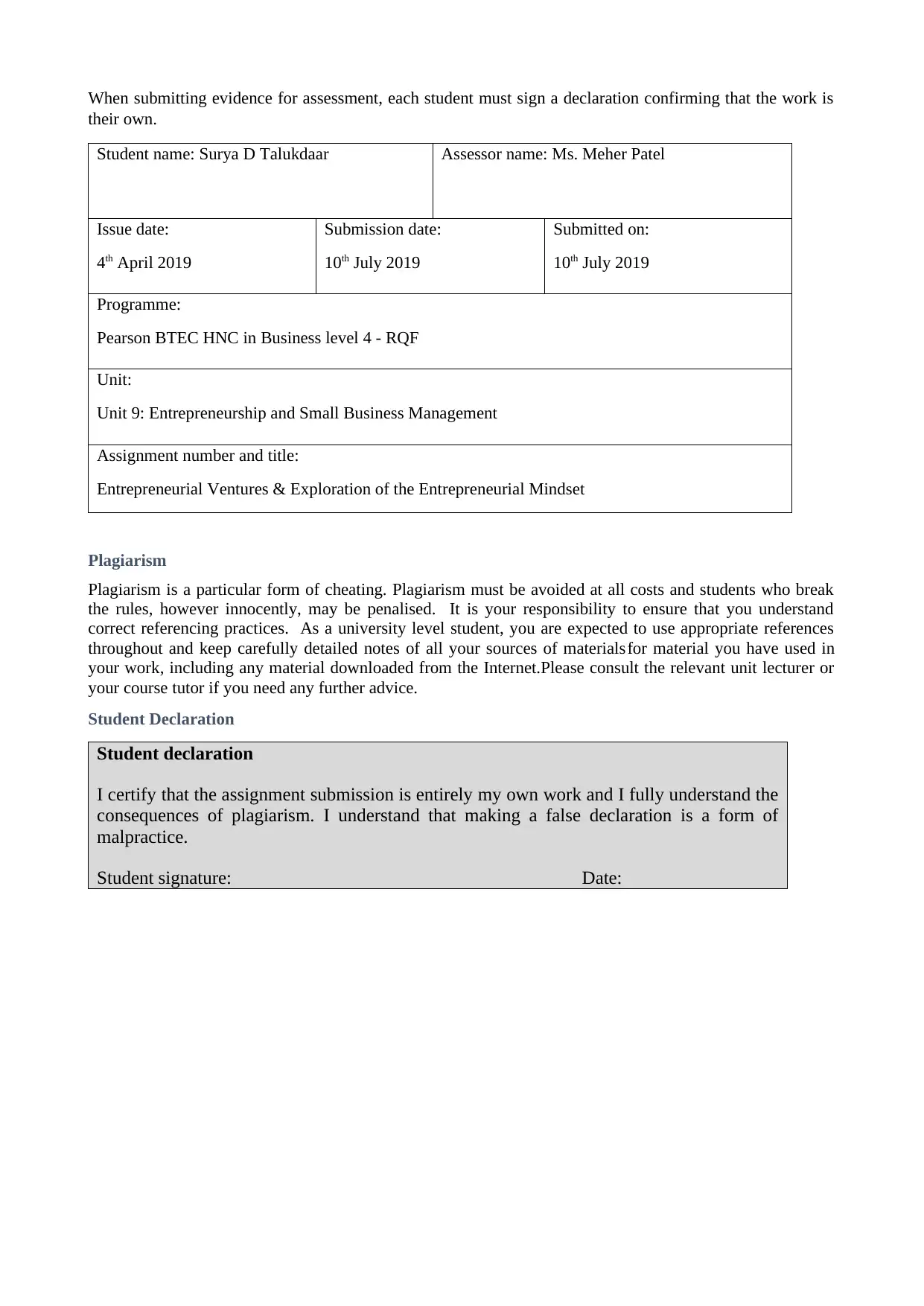
When submitting evidence for assessment, each student must sign a declaration confirming that the work is
their own.
Student name: Surya D Talukdaar Assessor name: Ms. Meher Patel
Issue date:
4th April 2019
Submission date:
10th July 2019
Submitted on:
10th July 2019
Programme:
Pearson BTEC HNC in Business level 4 - RQF
Unit:
Unit 9: Entrepreneurship and Small Business Management
Assignment number and title:
Entrepreneurial Ventures & Exploration of the Entrepreneurial Mindset
Plagiarism
Plagiarism is a particular form of cheating. Plagiarism must be avoided at all costs and students who break
the rules, however innocently, may be penalised. It is your responsibility to ensure that you understand
correct referencing practices. As a university level student, you are expected to use appropriate references
throughout and keep carefully detailed notes of all your sources of materialsfor material you have used in
your work, including any material downloaded from the Internet.Please consult the relevant unit lecturer or
your course tutor if you need any further advice.
Student Declaration
Student declaration
I certify that the assignment submission is entirely my own work and I fully understand the
consequences of plagiarism. I understand that making a false declaration is a form of
malpractice.
Student signature: Date:
their own.
Student name: Surya D Talukdaar Assessor name: Ms. Meher Patel
Issue date:
4th April 2019
Submission date:
10th July 2019
Submitted on:
10th July 2019
Programme:
Pearson BTEC HNC in Business level 4 - RQF
Unit:
Unit 9: Entrepreneurship and Small Business Management
Assignment number and title:
Entrepreneurial Ventures & Exploration of the Entrepreneurial Mindset
Plagiarism
Plagiarism is a particular form of cheating. Plagiarism must be avoided at all costs and students who break
the rules, however innocently, may be penalised. It is your responsibility to ensure that you understand
correct referencing practices. As a university level student, you are expected to use appropriate references
throughout and keep carefully detailed notes of all your sources of materialsfor material you have used in
your work, including any material downloaded from the Internet.Please consult the relevant unit lecturer or
your course tutor if you need any further advice.
Student Declaration
Student declaration
I certify that the assignment submission is entirely my own work and I fully understand the
consequences of plagiarism. I understand that making a false declaration is a form of
malpractice.
Student signature: Date:
Paraphrase This Document
Need a fresh take? Get an instant paraphrase of this document with our AI Paraphraser
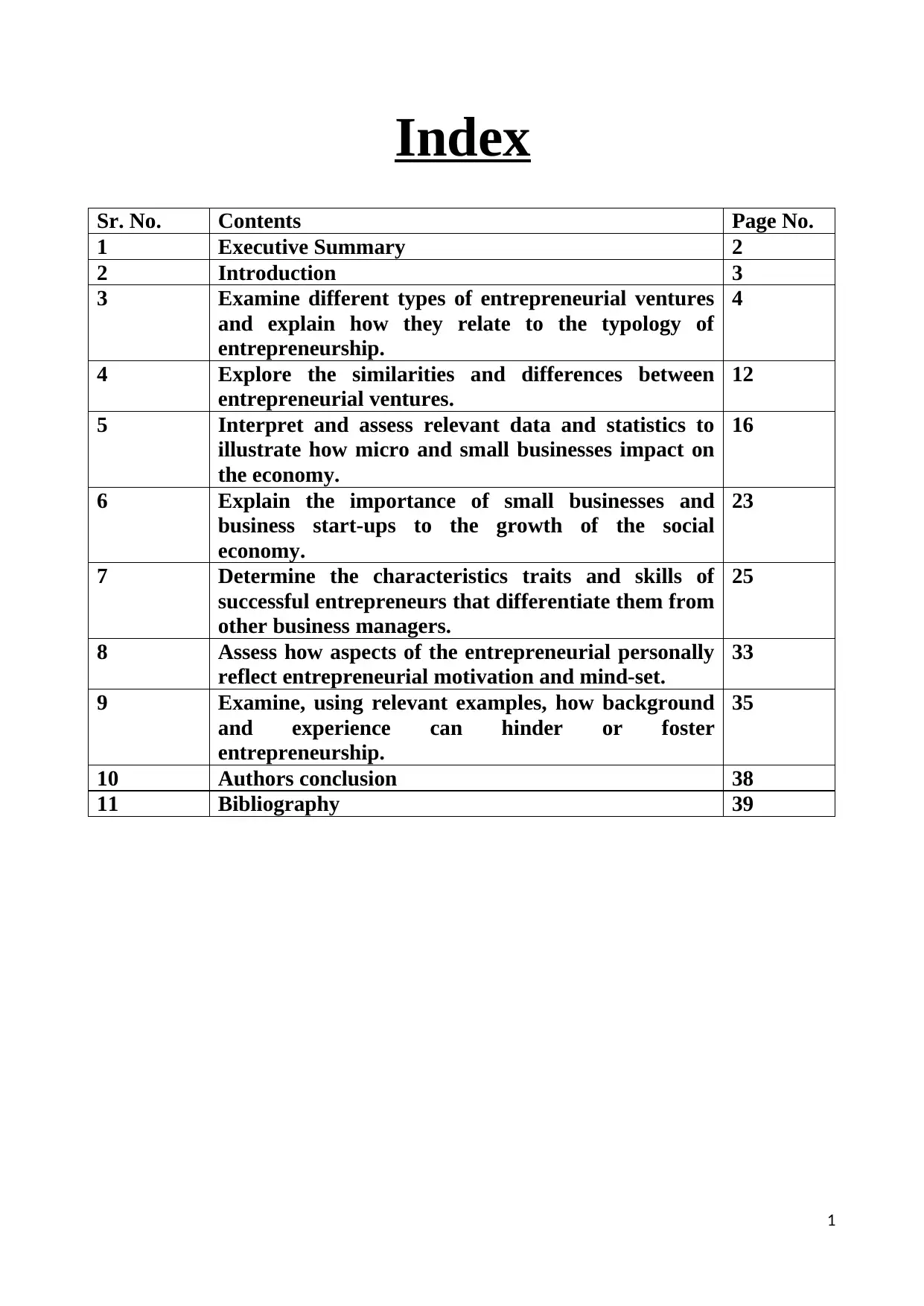
Index
Sr. No. Contents Page No.
1 Executive Summary 2
2 Introduction 3
3 Examine different types of entrepreneurial ventures
and explain how they relate to the typology of
entrepreneurship.
4
4 Explore the similarities and differences between
entrepreneurial ventures.
12
5 Interpret and assess relevant data and statistics to
illustrate how micro and small businesses impact on
the economy.
16
6 Explain the importance of small businesses and
business start-ups to the growth of the social
economy.
23
7 Determine the characteristics traits and skills of
successful entrepreneurs that differentiate them from
other business managers.
25
8 Assess how aspects of the entrepreneurial personally
reflect entrepreneurial motivation and mind-set.
33
9 Examine, using relevant examples, how background
and experience can hinder or foster
entrepreneurship.
35
10 Authors conclusion 38
11 Bibliography 39
1
Sr. No. Contents Page No.
1 Executive Summary 2
2 Introduction 3
3 Examine different types of entrepreneurial ventures
and explain how they relate to the typology of
entrepreneurship.
4
4 Explore the similarities and differences between
entrepreneurial ventures.
12
5 Interpret and assess relevant data and statistics to
illustrate how micro and small businesses impact on
the economy.
16
6 Explain the importance of small businesses and
business start-ups to the growth of the social
economy.
23
7 Determine the characteristics traits and skills of
successful entrepreneurs that differentiate them from
other business managers.
25
8 Assess how aspects of the entrepreneurial personally
reflect entrepreneurial motivation and mind-set.
33
9 Examine, using relevant examples, how background
and experience can hinder or foster
entrepreneurship.
35
10 Authors conclusion 38
11 Bibliography 39
1
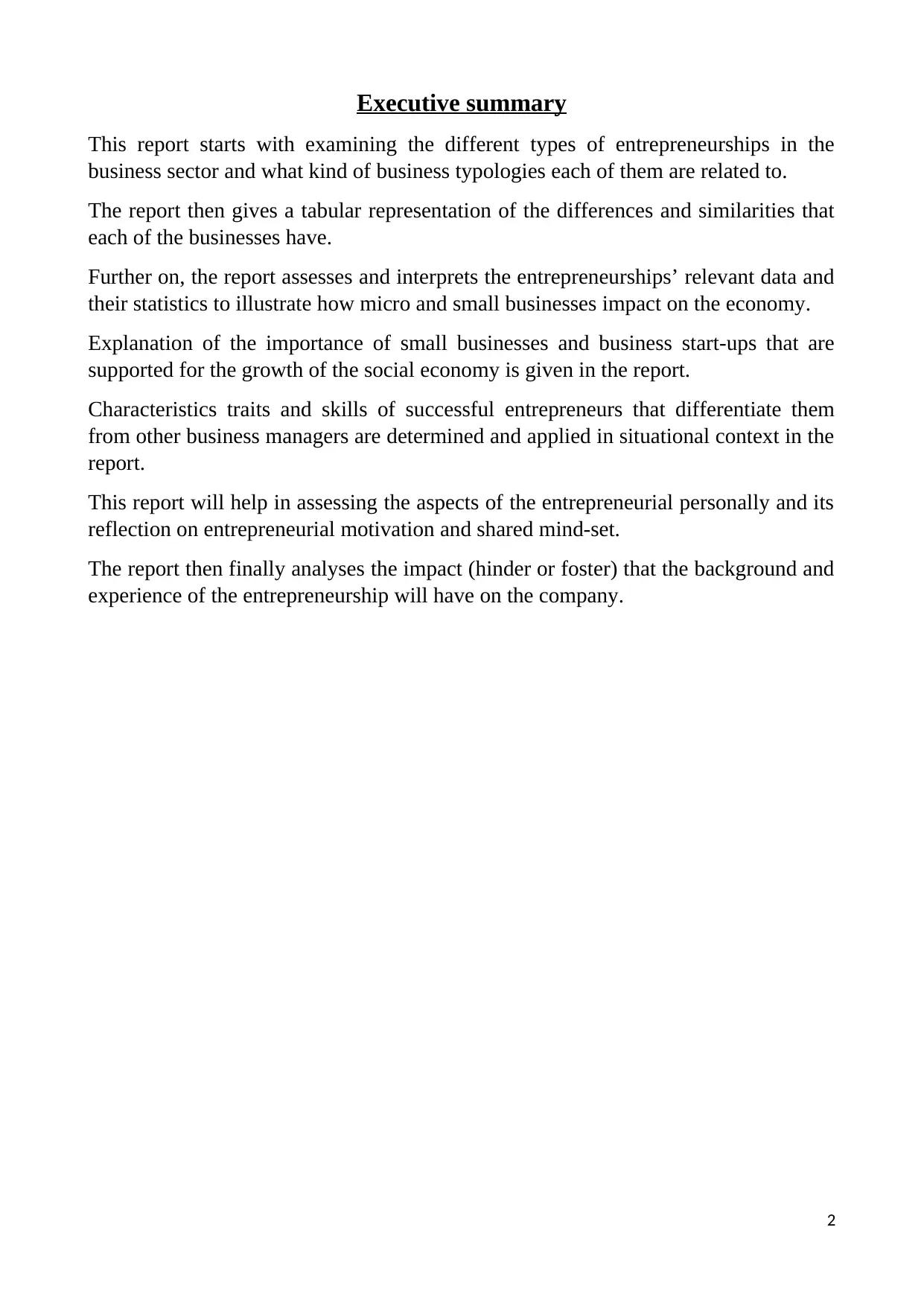
Executive summary
This report starts with examining the different types of entrepreneurships in the
business sector and what kind of business typologies each of them are related to.
The report then gives a tabular representation of the differences and similarities that
each of the businesses have.
Further on, the report assesses and interprets the entrepreneurships’ relevant data and
their statistics to illustrate how micro and small businesses impact on the economy.
Explanation of the importance of small businesses and business start-ups that are
supported for the growth of the social economy is given in the report.
Characteristics traits and skills of successful entrepreneurs that differentiate them
from other business managers are determined and applied in situational context in the
report.
This report will help in assessing the aspects of the entrepreneurial personally and its
reflection on entrepreneurial motivation and shared mind-set.
The report then finally analyses the impact (hinder or foster) that the background and
experience of the entrepreneurship will have on the company.
2
This report starts with examining the different types of entrepreneurships in the
business sector and what kind of business typologies each of them are related to.
The report then gives a tabular representation of the differences and similarities that
each of the businesses have.
Further on, the report assesses and interprets the entrepreneurships’ relevant data and
their statistics to illustrate how micro and small businesses impact on the economy.
Explanation of the importance of small businesses and business start-ups that are
supported for the growth of the social economy is given in the report.
Characteristics traits and skills of successful entrepreneurs that differentiate them
from other business managers are determined and applied in situational context in the
report.
This report will help in assessing the aspects of the entrepreneurial personally and its
reflection on entrepreneurial motivation and shared mind-set.
The report then finally analyses the impact (hinder or foster) that the background and
experience of the entrepreneurship will have on the company.
2
⊘ This is a preview!⊘
Do you want full access?
Subscribe today to unlock all pages.

Trusted by 1+ million students worldwide

Introduction
Shree Mahila Griha Udyog Lijjat Papad, more commonly known as Lijjat, is a
women’s cooperative that is in the manufacturing of multiple fast-moving consumer
goods.
It currently has operations all over India and does a significant amount of export of
their products.
The products it sells include Papad, detergent, soaps, cottage leather, incense sticks,
matches, etc.
It has employed 43000 employees, majority of which is made up of women. As of the
last recorded profit, it had earned over 109 million dollars.
3
Shree Mahila Griha Udyog Lijjat Papad, more commonly known as Lijjat, is a
women’s cooperative that is in the manufacturing of multiple fast-moving consumer
goods.
It currently has operations all over India and does a significant amount of export of
their products.
The products it sells include Papad, detergent, soaps, cottage leather, incense sticks,
matches, etc.
It has employed 43000 employees, majority of which is made up of women. As of the
last recorded profit, it had earned over 109 million dollars.
3
Paraphrase This Document
Need a fresh take? Get an instant paraphrase of this document with our AI Paraphraser
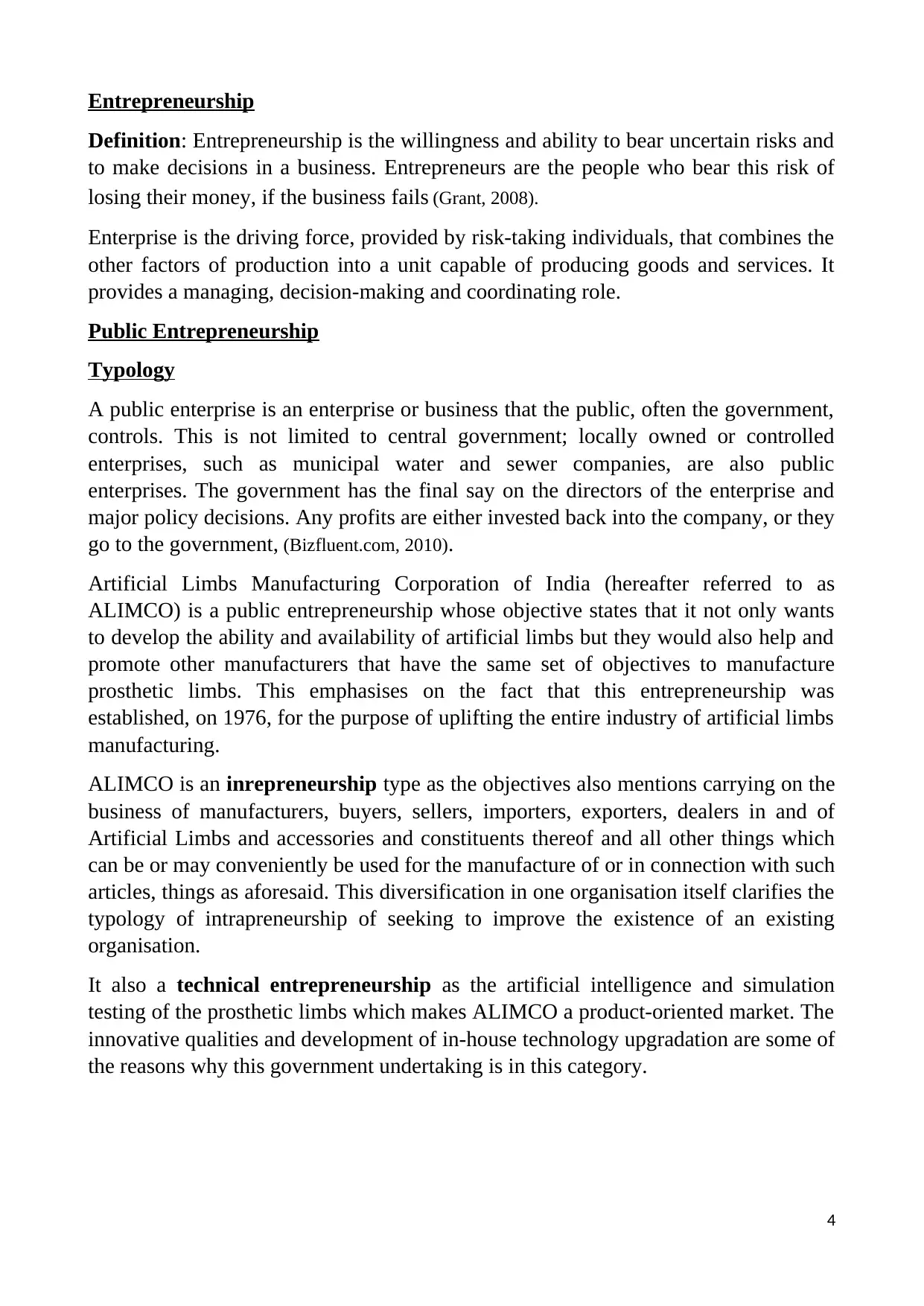
Entrepreneurship
Definition: Entrepreneurship is the willingness and ability to bear uncertain risks and
to make decisions in a business. Entrepreneurs are the people who bear this risk of
losing their money, if the business fails (Grant, 2008).
Enterprise is the driving force, provided by risk-taking individuals, that combines the
other factors of production into a unit capable of producing goods and services. It
provides a managing, decision-making and coordinating role.
Public Entrepreneurship
Typology
A public enterprise is an enterprise or business that the public, often the government,
controls. This is not limited to central government; locally owned or controlled
enterprises, such as municipal water and sewer companies, are also public
enterprises. The government has the final say on the directors of the enterprise and
major policy decisions. Any profits are either invested back into the company, or they
go to the government, (Bizfluent.com, 2010).
Artificial Limbs Manufacturing Corporation of India (hereafter referred to as
ALIMCO) is a public entrepreneurship whose objective states that it not only wants
to develop the ability and availability of artificial limbs but they would also help and
promote other manufacturers that have the same set of objectives to manufacture
prosthetic limbs. This emphasises on the fact that this entrepreneurship was
established, on 1976, for the purpose of uplifting the entire industry of artificial limbs
manufacturing.
ALIMCO is an inrepreneurship type as the objectives also mentions carrying on the
business of manufacturers, buyers, sellers, importers, exporters, dealers in and of
Artificial Limbs and accessories and constituents thereof and all other things which
can be or may conveniently be used for the manufacture of or in connection with such
articles, things as aforesaid. This diversification in one organisation itself clarifies the
typology of intrapreneurship of seeking to improve the existence of an existing
organisation.
It also a technical entrepreneurship as the artificial intelligence and simulation
testing of the prosthetic limbs which makes ALIMCO a product-oriented market. The
innovative qualities and development of in-house technology upgradation are some of
the reasons why this government undertaking is in this category.
4
Definition: Entrepreneurship is the willingness and ability to bear uncertain risks and
to make decisions in a business. Entrepreneurs are the people who bear this risk of
losing their money, if the business fails (Grant, 2008).
Enterprise is the driving force, provided by risk-taking individuals, that combines the
other factors of production into a unit capable of producing goods and services. It
provides a managing, decision-making and coordinating role.
Public Entrepreneurship
Typology
A public enterprise is an enterprise or business that the public, often the government,
controls. This is not limited to central government; locally owned or controlled
enterprises, such as municipal water and sewer companies, are also public
enterprises. The government has the final say on the directors of the enterprise and
major policy decisions. Any profits are either invested back into the company, or they
go to the government, (Bizfluent.com, 2010).
Artificial Limbs Manufacturing Corporation of India (hereafter referred to as
ALIMCO) is a public entrepreneurship whose objective states that it not only wants
to develop the ability and availability of artificial limbs but they would also help and
promote other manufacturers that have the same set of objectives to manufacture
prosthetic limbs. This emphasises on the fact that this entrepreneurship was
established, on 1976, for the purpose of uplifting the entire industry of artificial limbs
manufacturing.
ALIMCO is an inrepreneurship type as the objectives also mentions carrying on the
business of manufacturers, buyers, sellers, importers, exporters, dealers in and of
Artificial Limbs and accessories and constituents thereof and all other things which
can be or may conveniently be used for the manufacture of or in connection with such
articles, things as aforesaid. This diversification in one organisation itself clarifies the
typology of intrapreneurship of seeking to improve the existence of an existing
organisation.
It also a technical entrepreneurship as the artificial intelligence and simulation
testing of the prosthetic limbs which makes ALIMCO a product-oriented market. The
innovative qualities and development of in-house technology upgradation are some of
the reasons why this government undertaking is in this category.
4
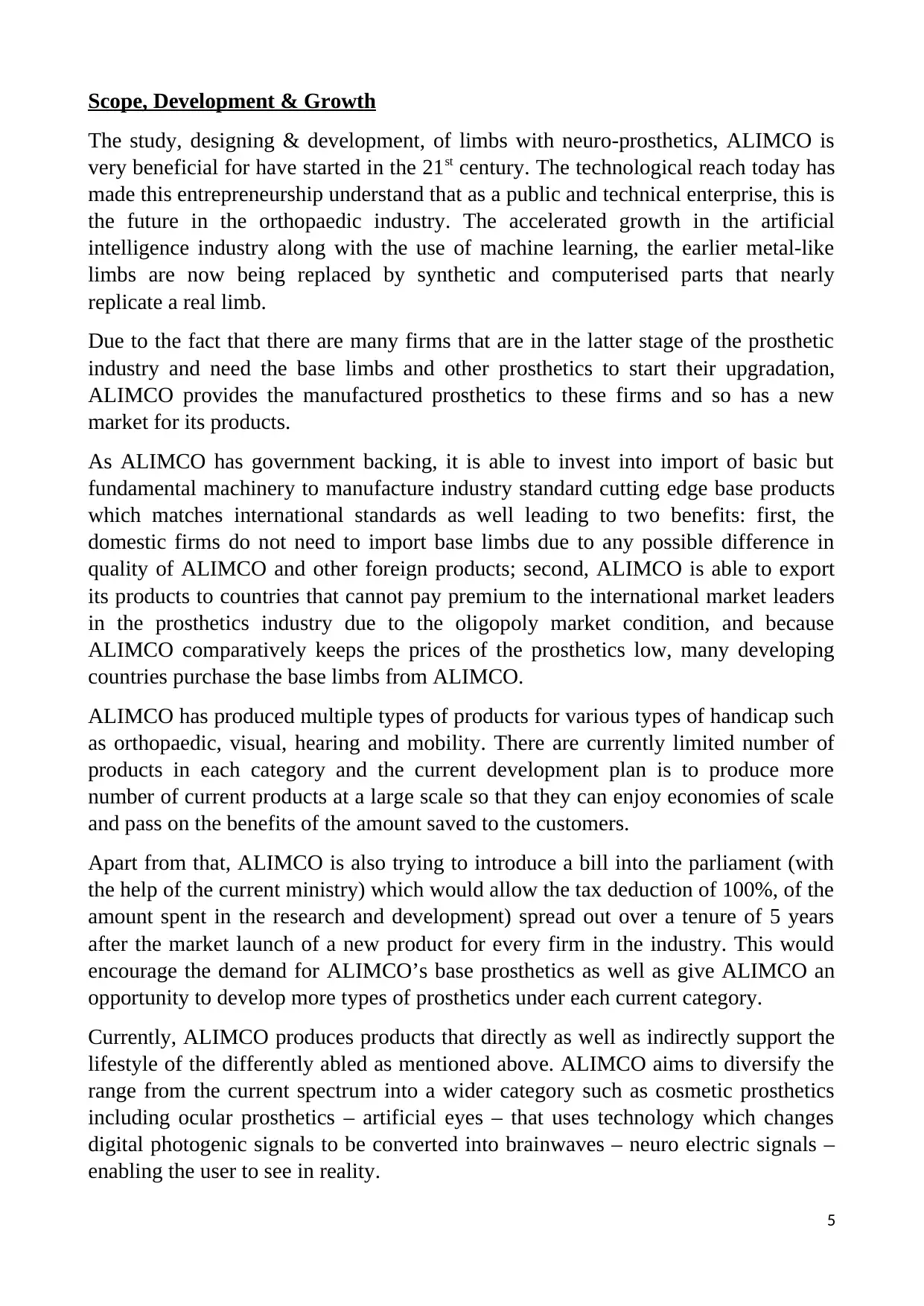
Scope, Development & Growth
The study, designing & development, of limbs with neuro-prosthetics, ALIMCO is
very beneficial for have started in the 21st century. The technological reach today has
made this entrepreneurship understand that as a public and technical enterprise, this is
the future in the orthopaedic industry. The accelerated growth in the artificial
intelligence industry along with the use of machine learning, the earlier metal-like
limbs are now being replaced by synthetic and computerised parts that nearly
replicate a real limb.
Due to the fact that there are many firms that are in the latter stage of the prosthetic
industry and need the base limbs and other prosthetics to start their upgradation,
ALIMCO provides the manufactured prosthetics to these firms and so has a new
market for its products.
As ALIMCO has government backing, it is able to invest into import of basic but
fundamental machinery to manufacture industry standard cutting edge base products
which matches international standards as well leading to two benefits: first, the
domestic firms do not need to import base limbs due to any possible difference in
quality of ALIMCO and other foreign products; second, ALIMCO is able to export
its products to countries that cannot pay premium to the international market leaders
in the prosthetics industry due to the oligopoly market condition, and because
ALIMCO comparatively keeps the prices of the prosthetics low, many developing
countries purchase the base limbs from ALIMCO.
ALIMCO has produced multiple types of products for various types of handicap such
as orthopaedic, visual, hearing and mobility. There are currently limited number of
products in each category and the current development plan is to produce more
number of current products at a large scale so that they can enjoy economies of scale
and pass on the benefits of the amount saved to the customers.
Apart from that, ALIMCO is also trying to introduce a bill into the parliament (with
the help of the current ministry) which would allow the tax deduction of 100%, of the
amount spent in the research and development) spread out over a tenure of 5 years
after the market launch of a new product for every firm in the industry. This would
encourage the demand for ALIMCO’s base prosthetics as well as give ALIMCO an
opportunity to develop more types of prosthetics under each current category.
Currently, ALIMCO produces products that directly as well as indirectly support the
lifestyle of the differently abled as mentioned above. ALIMCO aims to diversify the
range from the current spectrum into a wider category such as cosmetic prosthetics
including ocular prosthetics – artificial eyes – that uses technology which changes
digital photogenic signals to be converted into brainwaves – neuro electric signals –
enabling the user to see in reality.
5
The study, designing & development, of limbs with neuro-prosthetics, ALIMCO is
very beneficial for have started in the 21st century. The technological reach today has
made this entrepreneurship understand that as a public and technical enterprise, this is
the future in the orthopaedic industry. The accelerated growth in the artificial
intelligence industry along with the use of machine learning, the earlier metal-like
limbs are now being replaced by synthetic and computerised parts that nearly
replicate a real limb.
Due to the fact that there are many firms that are in the latter stage of the prosthetic
industry and need the base limbs and other prosthetics to start their upgradation,
ALIMCO provides the manufactured prosthetics to these firms and so has a new
market for its products.
As ALIMCO has government backing, it is able to invest into import of basic but
fundamental machinery to manufacture industry standard cutting edge base products
which matches international standards as well leading to two benefits: first, the
domestic firms do not need to import base limbs due to any possible difference in
quality of ALIMCO and other foreign products; second, ALIMCO is able to export
its products to countries that cannot pay premium to the international market leaders
in the prosthetics industry due to the oligopoly market condition, and because
ALIMCO comparatively keeps the prices of the prosthetics low, many developing
countries purchase the base limbs from ALIMCO.
ALIMCO has produced multiple types of products for various types of handicap such
as orthopaedic, visual, hearing and mobility. There are currently limited number of
products in each category and the current development plan is to produce more
number of current products at a large scale so that they can enjoy economies of scale
and pass on the benefits of the amount saved to the customers.
Apart from that, ALIMCO is also trying to introduce a bill into the parliament (with
the help of the current ministry) which would allow the tax deduction of 100%, of the
amount spent in the research and development) spread out over a tenure of 5 years
after the market launch of a new product for every firm in the industry. This would
encourage the demand for ALIMCO’s base prosthetics as well as give ALIMCO an
opportunity to develop more types of prosthetics under each current category.
Currently, ALIMCO produces products that directly as well as indirectly support the
lifestyle of the differently abled as mentioned above. ALIMCO aims to diversify the
range from the current spectrum into a wider category such as cosmetic prosthetics
including ocular prosthetics – artificial eyes – that uses technology which changes
digital photogenic signals to be converted into brainwaves – neuro electric signals –
enabling the user to see in reality.
5
⊘ This is a preview!⊘
Do you want full access?
Subscribe today to unlock all pages.

Trusted by 1+ million students worldwide
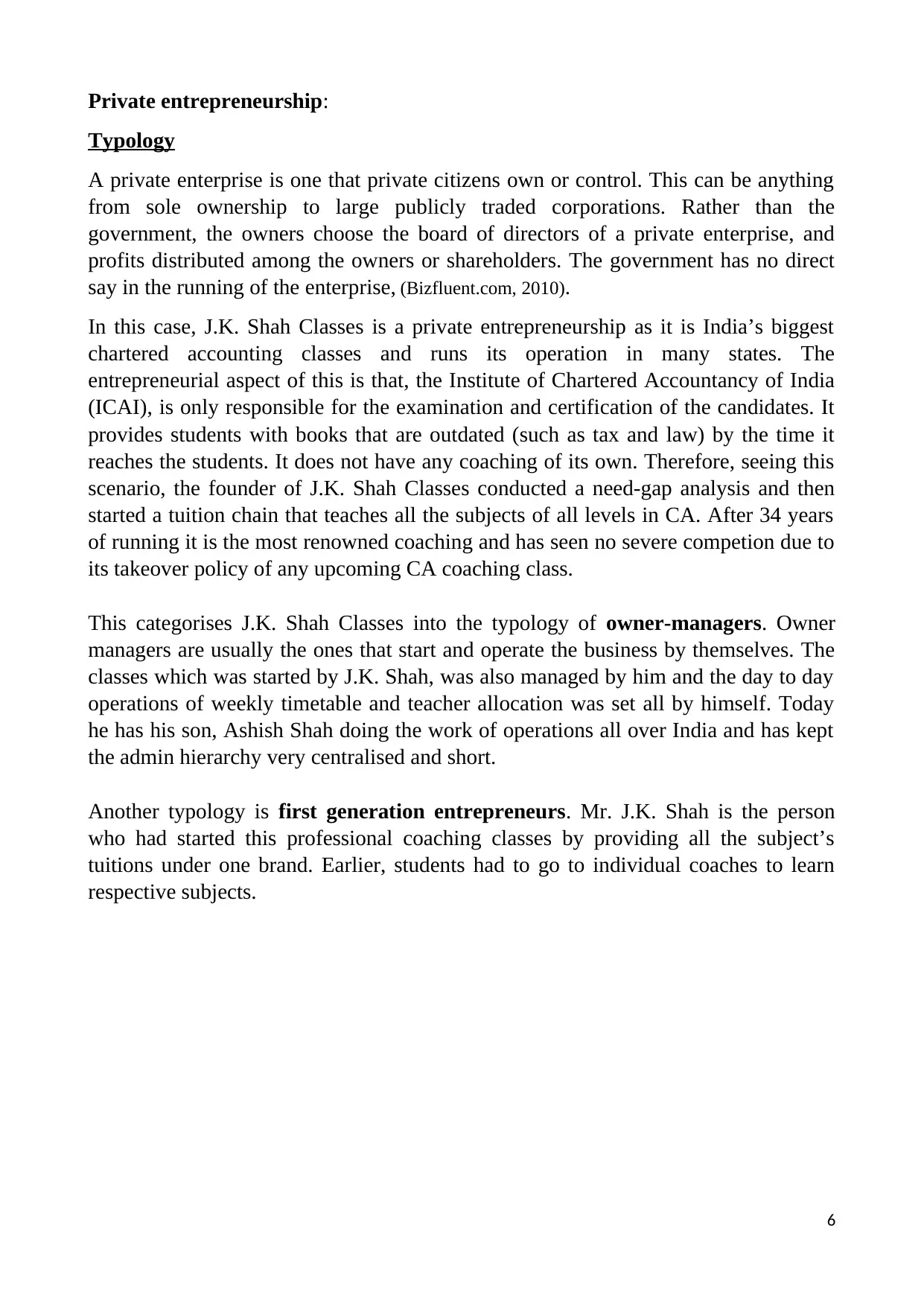
Private entrepreneurship:
Typology
A private enterprise is one that private citizens own or control. This can be anything
from sole ownership to large publicly traded corporations. Rather than the
government, the owners choose the board of directors of a private enterprise, and
profits distributed among the owners or shareholders. The government has no direct
say in the running of the enterprise, (Bizfluent.com, 2010).
In this case, J.K. Shah Classes is a private entrepreneurship as it is India’s biggest
chartered accounting classes and runs its operation in many states. The
entrepreneurial aspect of this is that, the Institute of Chartered Accountancy of India
(ICAI), is only responsible for the examination and certification of the candidates. It
provides students with books that are outdated (such as tax and law) by the time it
reaches the students. It does not have any coaching of its own. Therefore, seeing this
scenario, the founder of J.K. Shah Classes conducted a need-gap analysis and then
started a tuition chain that teaches all the subjects of all levels in CA. After 34 years
of running it is the most renowned coaching and has seen no severe competion due to
its takeover policy of any upcoming CA coaching class.
This categorises J.K. Shah Classes into the typology of owner-managers. Owner
managers are usually the ones that start and operate the business by themselves. The
classes which was started by J.K. Shah, was also managed by him and the day to day
operations of weekly timetable and teacher allocation was set all by himself. Today
he has his son, Ashish Shah doing the work of operations all over India and has kept
the admin hierarchy very centralised and short.
Another typology is first generation entrepreneurs. Mr. J.K. Shah is the person
who had started this professional coaching classes by providing all the subject’s
tuitions under one brand. Earlier, students had to go to individual coaches to learn
respective subjects.
6
Typology
A private enterprise is one that private citizens own or control. This can be anything
from sole ownership to large publicly traded corporations. Rather than the
government, the owners choose the board of directors of a private enterprise, and
profits distributed among the owners or shareholders. The government has no direct
say in the running of the enterprise, (Bizfluent.com, 2010).
In this case, J.K. Shah Classes is a private entrepreneurship as it is India’s biggest
chartered accounting classes and runs its operation in many states. The
entrepreneurial aspect of this is that, the Institute of Chartered Accountancy of India
(ICAI), is only responsible for the examination and certification of the candidates. It
provides students with books that are outdated (such as tax and law) by the time it
reaches the students. It does not have any coaching of its own. Therefore, seeing this
scenario, the founder of J.K. Shah Classes conducted a need-gap analysis and then
started a tuition chain that teaches all the subjects of all levels in CA. After 34 years
of running it is the most renowned coaching and has seen no severe competion due to
its takeover policy of any upcoming CA coaching class.
This categorises J.K. Shah Classes into the typology of owner-managers. Owner
managers are usually the ones that start and operate the business by themselves. The
classes which was started by J.K. Shah, was also managed by him and the day to day
operations of weekly timetable and teacher allocation was set all by himself. Today
he has his son, Ashish Shah doing the work of operations all over India and has kept
the admin hierarchy very centralised and short.
Another typology is first generation entrepreneurs. Mr. J.K. Shah is the person
who had started this professional coaching classes by providing all the subject’s
tuitions under one brand. Earlier, students had to go to individual coaches to learn
respective subjects.
6
Paraphrase This Document
Need a fresh take? Get an instant paraphrase of this document with our AI Paraphraser
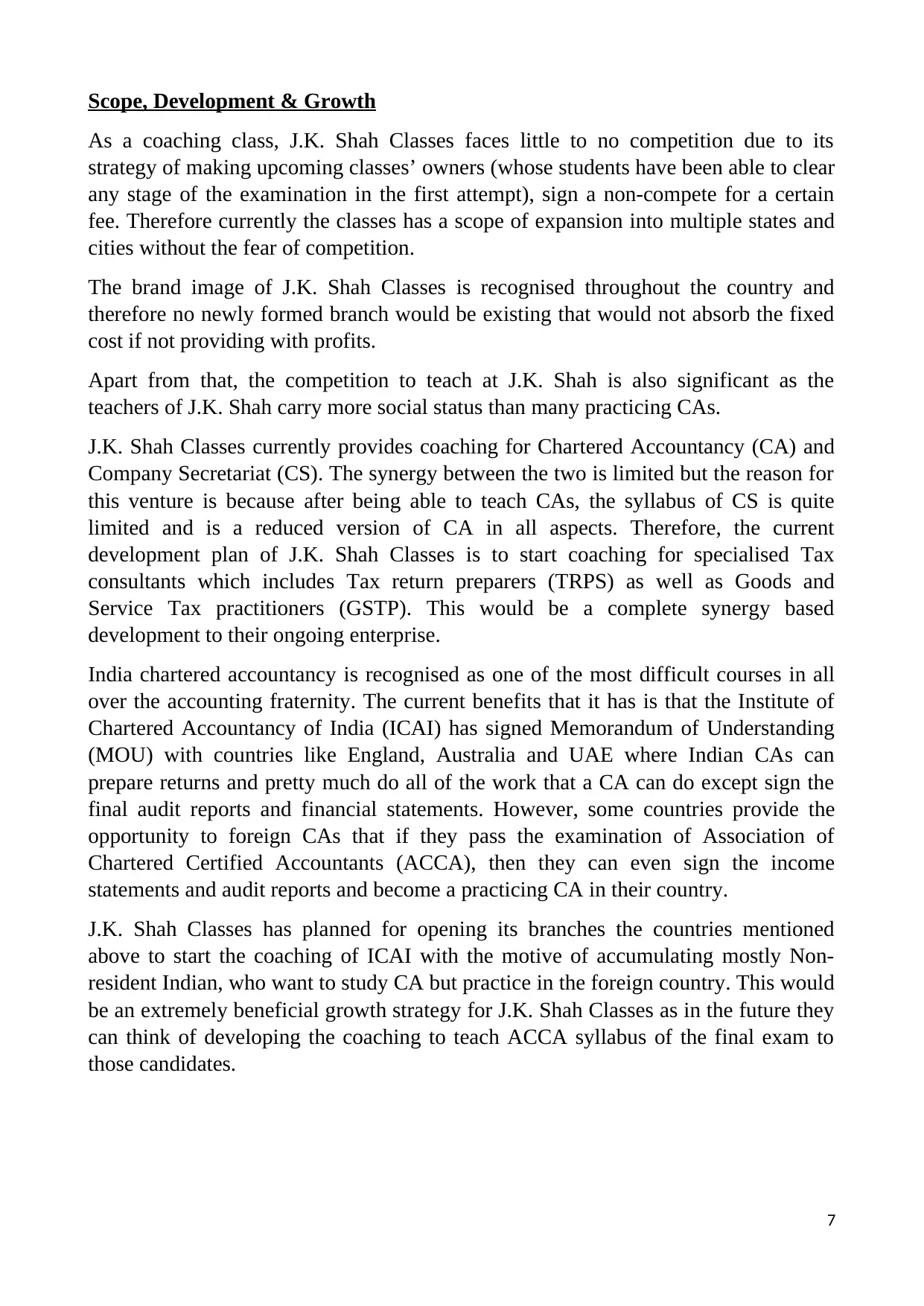
Scope, Development & Growth
As a coaching class, J.K. Shah Classes faces little to no competition due to its
strategy of making upcoming classes’ owners (whose students have been able to clear
any stage of the examination in the first attempt), sign a non-compete for a certain
fee. Therefore currently the classes has a scope of expansion into multiple states and
cities without the fear of competition.
The brand image of J.K. Shah Classes is recognised throughout the country and
therefore no newly formed branch would be existing that would not absorb the fixed
cost if not providing with profits.
Apart from that, the competition to teach at J.K. Shah is also significant as the
teachers of J.K. Shah carry more social status than many practicing CAs.
J.K. Shah Classes currently provides coaching for Chartered Accountancy (CA) and
Company Secretariat (CS). The synergy between the two is limited but the reason for
this venture is because after being able to teach CAs, the syllabus of CS is quite
limited and is a reduced version of CA in all aspects. Therefore, the current
development plan of J.K. Shah Classes is to start coaching for specialised Tax
consultants which includes Tax return preparers (TRPS) as well as Goods and
Service Tax practitioners (GSTP). This would be a complete synergy based
development to their ongoing enterprise.
India chartered accountancy is recognised as one of the most difficult courses in all
over the accounting fraternity. The current benefits that it has is that the Institute of
Chartered Accountancy of India (ICAI) has signed Memorandum of Understanding
(MOU) with countries like England, Australia and UAE where Indian CAs can
prepare returns and pretty much do all of the work that a CA can do except sign the
final audit reports and financial statements. However, some countries provide the
opportunity to foreign CAs that if they pass the examination of Association of
Chartered Certified Accountants (ACCA), then they can even sign the income
statements and audit reports and become a practicing CA in their country.
J.K. Shah Classes has planned for opening its branches the countries mentioned
above to start the coaching of ICAI with the motive of accumulating mostly Non-
resident Indian, who want to study CA but practice in the foreign country. This would
be an extremely beneficial growth strategy for J.K. Shah Classes as in the future they
can think of developing the coaching to teach ACCA syllabus of the final exam to
those candidates.
7
As a coaching class, J.K. Shah Classes faces little to no competition due to its
strategy of making upcoming classes’ owners (whose students have been able to clear
any stage of the examination in the first attempt), sign a non-compete for a certain
fee. Therefore currently the classes has a scope of expansion into multiple states and
cities without the fear of competition.
The brand image of J.K. Shah Classes is recognised throughout the country and
therefore no newly formed branch would be existing that would not absorb the fixed
cost if not providing with profits.
Apart from that, the competition to teach at J.K. Shah is also significant as the
teachers of J.K. Shah carry more social status than many practicing CAs.
J.K. Shah Classes currently provides coaching for Chartered Accountancy (CA) and
Company Secretariat (CS). The synergy between the two is limited but the reason for
this venture is because after being able to teach CAs, the syllabus of CS is quite
limited and is a reduced version of CA in all aspects. Therefore, the current
development plan of J.K. Shah Classes is to start coaching for specialised Tax
consultants which includes Tax return preparers (TRPS) as well as Goods and
Service Tax practitioners (GSTP). This would be a complete synergy based
development to their ongoing enterprise.
India chartered accountancy is recognised as one of the most difficult courses in all
over the accounting fraternity. The current benefits that it has is that the Institute of
Chartered Accountancy of India (ICAI) has signed Memorandum of Understanding
(MOU) with countries like England, Australia and UAE where Indian CAs can
prepare returns and pretty much do all of the work that a CA can do except sign the
final audit reports and financial statements. However, some countries provide the
opportunity to foreign CAs that if they pass the examination of Association of
Chartered Certified Accountants (ACCA), then they can even sign the income
statements and audit reports and become a practicing CA in their country.
J.K. Shah Classes has planned for opening its branches the countries mentioned
above to start the coaching of ICAI with the motive of accumulating mostly Non-
resident Indian, who want to study CA but practice in the foreign country. This would
be an extremely beneficial growth strategy for J.K. Shah Classes as in the future they
can think of developing the coaching to teach ACCA syllabus of the final exam to
those candidates.
7
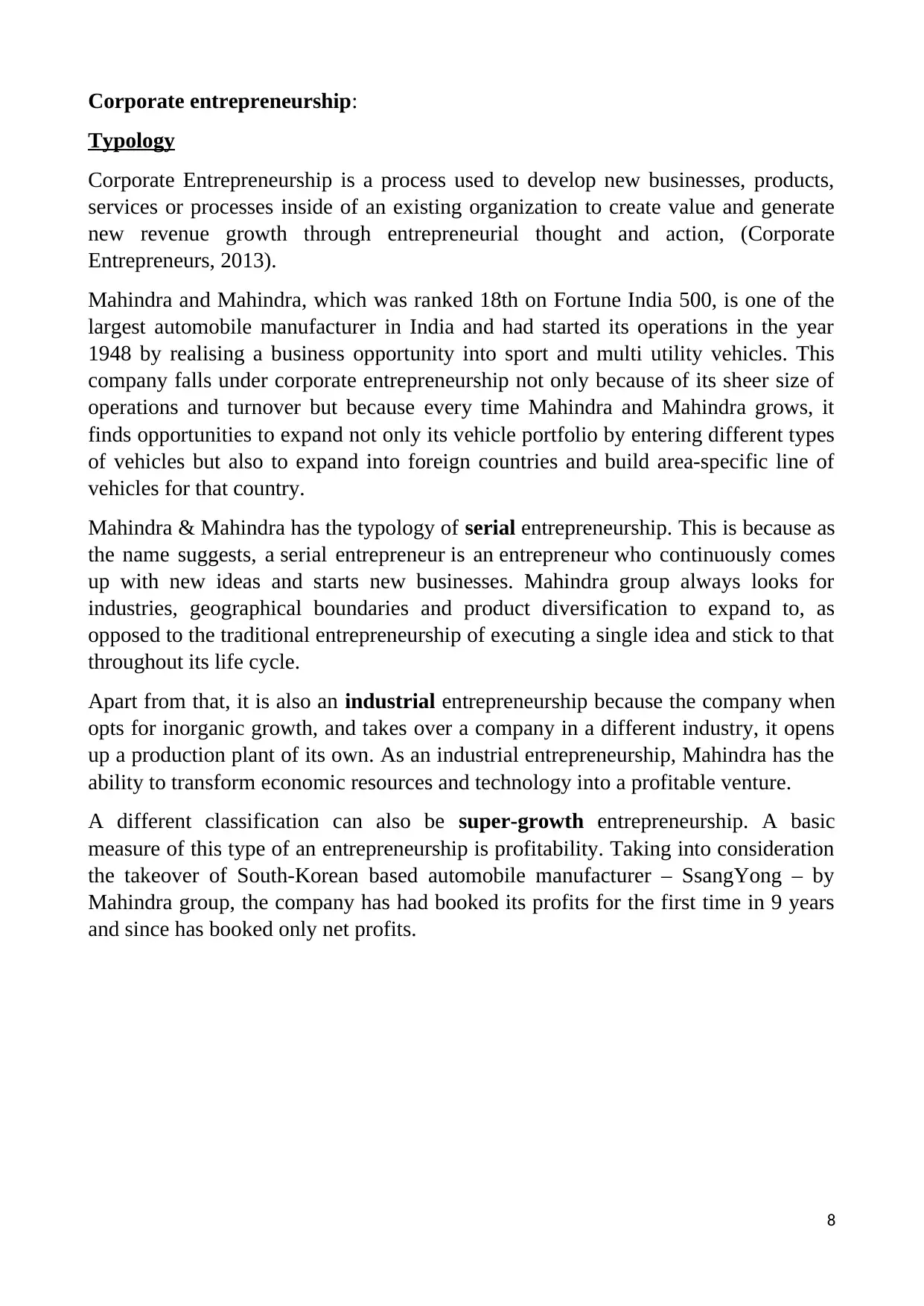
Corporate entrepreneurship:
Typology
Corporate Entrepreneurship is a process used to develop new businesses, products,
services or processes inside of an existing organization to create value and generate
new revenue growth through entrepreneurial thought and action, (Corporate
Entrepreneurs, 2013).
Mahindra and Mahindra, which was ranked 18th on Fortune India 500, is one of the
largest automobile manufacturer in India and had started its operations in the year
1948 by realising a business opportunity into sport and multi utility vehicles. This
company falls under corporate entrepreneurship not only because of its sheer size of
operations and turnover but because every time Mahindra and Mahindra grows, it
finds opportunities to expand not only its vehicle portfolio by entering different types
of vehicles but also to expand into foreign countries and build area-specific line of
vehicles for that country.
Mahindra & Mahindra has the typology of serial entrepreneurship. This is because as
the name suggests, a serial entrepreneur is an entrepreneur who continuously comes
up with new ideas and starts new businesses. Mahindra group always looks for
industries, geographical boundaries and product diversification to expand to, as
opposed to the traditional entrepreneurship of executing a single idea and stick to that
throughout its life cycle.
Apart from that, it is also an industrial entrepreneurship because the company when
opts for inorganic growth, and takes over a company in a different industry, it opens
up a production plant of its own. As an industrial entrepreneurship, Mahindra has the
ability to transform economic resources and technology into a profitable venture.
A different classification can also be super-growth entrepreneurship. A basic
measure of this type of an entrepreneurship is profitability. Taking into consideration
the takeover of South-Korean based automobile manufacturer – SsangYong – by
Mahindra group, the company has had booked its profits for the first time in 9 years
and since has booked only net profits.
8
Typology
Corporate Entrepreneurship is a process used to develop new businesses, products,
services or processes inside of an existing organization to create value and generate
new revenue growth through entrepreneurial thought and action, (Corporate
Entrepreneurs, 2013).
Mahindra and Mahindra, which was ranked 18th on Fortune India 500, is one of the
largest automobile manufacturer in India and had started its operations in the year
1948 by realising a business opportunity into sport and multi utility vehicles. This
company falls under corporate entrepreneurship not only because of its sheer size of
operations and turnover but because every time Mahindra and Mahindra grows, it
finds opportunities to expand not only its vehicle portfolio by entering different types
of vehicles but also to expand into foreign countries and build area-specific line of
vehicles for that country.
Mahindra & Mahindra has the typology of serial entrepreneurship. This is because as
the name suggests, a serial entrepreneur is an entrepreneur who continuously comes
up with new ideas and starts new businesses. Mahindra group always looks for
industries, geographical boundaries and product diversification to expand to, as
opposed to the traditional entrepreneurship of executing a single idea and stick to that
throughout its life cycle.
Apart from that, it is also an industrial entrepreneurship because the company when
opts for inorganic growth, and takes over a company in a different industry, it opens
up a production plant of its own. As an industrial entrepreneurship, Mahindra has the
ability to transform economic resources and technology into a profitable venture.
A different classification can also be super-growth entrepreneurship. A basic
measure of this type of an entrepreneurship is profitability. Taking into consideration
the takeover of South-Korean based automobile manufacturer – SsangYong – by
Mahindra group, the company has had booked its profits for the first time in 9 years
and since has booked only net profits.
8
⊘ This is a preview!⊘
Do you want full access?
Subscribe today to unlock all pages.

Trusted by 1+ million students worldwide
1 out of 44
Related Documents
Your All-in-One AI-Powered Toolkit for Academic Success.
+13062052269
info@desklib.com
Available 24*7 on WhatsApp / Email
![[object Object]](/_next/static/media/star-bottom.7253800d.svg)
Unlock your academic potential
Copyright © 2020–2025 A2Z Services. All Rights Reserved. Developed and managed by ZUCOL.





